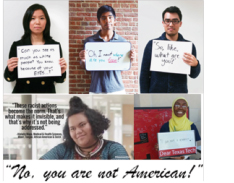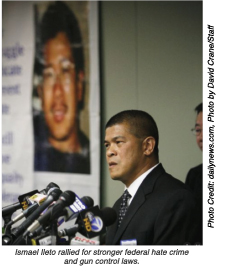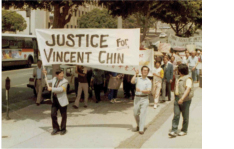Grades: 11-12Subject:
English Language Arts
Number of Lessons: 10
This unit exposes students to a conversation around civil rights through the study of two hate crime incidents affecting Asian Americans: Vincent Chin and Joseph Ileto. Through this unit, students will also explore the treatment of Asian Americans and the fight for racial and cultural equality in the United States. They will also discuss discrimination and microaggressions. In this unit, students will engage academic vocabulary, critically read and analyze a variety of expository texts, and write an argumentative essay as their culminating task.
Students will:
- Understand and use academic vocabulary in context
- Use historical context to analyze an informational text’s meaning
- Synthesize multiple genres of text, for recurring themes, connections and differences
- Write a strong argumentative essay, backing up claims with specific textual evidence
- Write clearly, paying attention to organization, audience, format and purpose
- Use the writing process to develop and improve essays
- Present and discuss ideas with classmates, based upon an informational text, supporting opinions with textual detail
- Why have Asian Americans been targets of hate crimes and discrimination?
- How has the Asian American community responded to these incidents?
- How has the media portrayed Asian Americans? How have they responded to these incidents?
- How do discrimination and microaggressions affect minority groups in society?
- What can be done to prevent further discrimination and hate crimes in our society?
- “Academic Vocabulary Hate Crimes Microaggressions” worksheet (student and teacher versions)
- “Asian American Hate Crimes: The Lives of Vincent Chin and Joseph Ileto” articles
- “Essay Rubric Hate Crimes Microaggressions” worksheet
- “Microaggressions Slides”
- “RAFT Essay Prompt Hate Crimes Microaggressions” worksheet
- “Reader’s Anticipation Guide Hate Crimes Microaggressions” worksheet
- “Tree Map Hate Crimes Microaggressions” graphic organizer worksheet
- “Unit Slides ELA Gr 11-12 Hate Crimes Microaggressions"
- “Unit Plan ELA Gr 11-12 Hate Crimes Microaggressions"
Recommended Supplemental Texts:
- “A Guide to Responding to Microaggressions” article
- “Detroit News Columnist Trivializes Vincent Chin's Murder and Its Legacy” statement
- “Ileto family remembers Joseph Ileto, slain 15 years ago” article
- “Survivors mark 10th anniversary of Granada Hills shooting” article
- “What we all assume we know about the Vincent Chin case probably isn't so” article
- “Why Vincent Chin Matters” article
LESSON 1:
Unit Introduction, Discrimination and Hate Crimes Overview (Suggested Time: 60 minutes)
Materials:
- “A Guide to Responding to Microaggressions” article
- “Microaggressions Slides”
- “Unit Slides ELA Gr 11-12 Hate Crimes Microaggressions”
Activity 1: Quick-Write / Journal Prompt (20 minutes)
- In order to connect to students’ prior knowledge and introduce some of the themes of the unit, have students complete a journal or “Quick-Write” for the following question (refer to Unit slides for the writing prompt):
Think of a recent story or current event where someone was unfairly discriminated against, due to their race, ethnicity, nationality, religion, gender or disability. What caused the incident and how did people respond?
- Students will write silently for 5-7 minutes, then have them share their ideas/writing with a partner. Make sure that students take turns sharing and listening.
- After students share with a partner, have them create a “Circle Map” on their papers (see unit slides) to list current events and incidents. Have students also explain what the outside influences might have been for each incident.
- Then, call on students to share their writing with the class. Have students write ideas on the Circle Map in their notes, in order to record their prior knowledge. The teacher may write these on the board or type them into the unit slides for students.
Activity 2: Microaggressions: Discrimination in Everyday Life (40 minutes)
- Introduce the following terms to the students:
- Discrimination: the practice of treating somebody or a particular group in society less fairly than others on the basis of race, color, sex, national origin, age, disability, and genetic information
- Hate Crimes: a crime that is committed against someone or property only because of the offender’s bias against a race, religion, disability, sexual orientation, ethnicity, gender, or gender identity
- Microaggressions: the everyday verbal, nonverbal, and environmental slights, snubs, or insults, whether intentional or unintentional, which communicate hostile, derogatory, or negative messages to target persons based solely upon their marginalized group membership
- Share the “Microaggressions Slides” with the class. Discuss the different types of microaggressions and have students analyze their effects on minority groups in society. Read and critically analyze the article, “A Guide to Responding to Microaggressions,” by Kevin Nadal (the chart on page 72 is particularly helpful).
- Below are some supplemental film clips you can share with students as well to encourage discussion about this kind of discrimination in everyday life.
Materials:
Videos on Microagressions:
- “Microaggressions in everyday life” (Derald Wing Sue, YouTube) Run time 4:26 minutes
- “Microaggressions: Comments that sting” (NYTimes) Run time 3:41 minutes
- “Microaggressions: The little things people say” (Youtube) Run time: 5:02 minutes
Discussion Questions:
- Can you identify any other examples of microaggressions?
- How do microaggressions affect people from minority groups in our society?
- What can be done to prevent this form of discrimination in everyday life?
LESSON 2: Academic Vocabulary, Reader's Anticipation Guide, Historical Context (Suggested Time: 60 minutes)
Materials:
- “Academic Vocabulary Hate Crimes Microaggressions” worksheet (student/teacher versions)
- “Asian American Hate Crimes: The Lives of Vincent Chin and Joseph Ileto” articles
- “Reader’s Anticipation Guide Hate Crimes Microaggressions” worksheet
- “Unit Slide ELA Gr 11-12 Hate Crimes Microaggressions”
Activity 1: Academic Vocabulary (20 minutes)
- Pass out the “Academic Vocabulary” student worksheet. Explain that these words are all academic vocabulary that students will use in this unit, but will also see in other subjects as well. Academic vocabulary is essential for improving as readers and writers. One of the goals of this unit is to encourage students to use these words appropriately in context.
- Using the teacher version of the worksheet, present each word to the students. After you say the word aloud, have the students repeat after you, to have students practice pronouncing the words verbally. Read the definition/explanation. Then, read the word in the context and have students fill in the blanks. Read each sentence twice.
- For a vocabulary practice activity, instruct the students to complete a new sentence for each word, using the example sentences on the worksheet as models. They must be “show-not-tell” sentences, meaning that they should show the meaning of the word, not just tell the meaning of the word.
Discourage "Telling Sentences":
- My best friend is eclectic.
- I don’t understand what eclectic means.
- Eclectic is a difficult word.
Encourage "Showing Sentences":
- Darin’s eclectic tastes in music range from hip hop and reggae to gospel and Broadway musicals.
Activity 2: Reader's Anticipation Guide (10 minutes)
- Pass out the “Reader’s Anticipation Guide” worksheet (refer to the unit slides for student instructions).
- Have the students complete the “before reading” side of the worksheet, marking whether they agree/disagree with the five statements. Note that the vocabulary words are underlined on the worksheet.
- Model the first statement to the class; then have the students complete the rest silently.
- After about 1-2 minutes, have class share whether they agreed/disagreed with the statements by raising hands.
Activity 3: Historical Context (30 minutes)
- To provide historical context for the articles, students will take notes on the film clips.
- Show 3-4 of the following videos, available online. Have students take notes on these resources. After showing each video, ask students how this history matches their ideas from the “Reader’s Anticipation Guide” worksheet before reading the articles.
Materials:
Videos on Vincent Chin:
- “Clip of ‘Carry the Tiger to the Mountain” (Vimeo) Run time 1:34 minutes
- "Vincent Who?" Interviews (NYTimes) Run time: various
- "Who Killed Vincent Chin?" (1987) Run time: 1 hr 22 minutes
Videos on Joseph Ileto:
- “Ileto family talks about Joseph Ileto, victim of hate crime” (YouTube) Run time 7:56 minutes
- "Joseph Ileto Mural" (YouTube) Run time: 2:58 minutes
LESSON 3:
Reading and Annotating the Text, Reader's Anticipation Guide (Suggested Time: 60 minutes)
Materials:
- “Asian American Hate Crimes: The Lives of Vincent Chin and Joseph Ileto” articles
- “Reader’s Anticipation Guide Hate Crimes Microaggressions” worksheet
- “Unit Slide ELA Gr 11-12 Hate Crimes Microaggressions”
Activity 1: Reading about Vincent Chin and Joseph Ileto (40 minutes)
- Before reading the articles, have students preview the text. Ask them to identify and discuss text features for 1-2 minutes: photos, title, subtitles, numbered paragraphs, underlined vocabulary words.
- Have students silently read the articles to familiarize students with the vocabulary, to get the “gist” of the story (5 minutes).
- While reading, students will mark up/annotate the text (See unit slides for student instructions)
- Underline important lines, with interesting or intriguing ideas.
- Draw a star next to main ideas.
- Circle new words/vocabulary.
- Write a question mark in the margins and list any questions you have about the text.
- Read the first article as a class, “Lily Chin: The Courage to Speak Out.” This section discusses the story of Vincent Chin, and the Asian American community’s response to his death. Either select students to read paragraphs, or the teacher should read aloud. Pause periodically to check for reading comprehension and to ask critical thinking questions about the article.
- Have students share their annotations, what they found surprising, important, or had questions about.
- Have the students read the Joseph Ileto article, “A Family Educates to Prevent Hate Crimes: The Case of Joseph Ileto.” This section discusses the killing of Joseph Ileto and the media’s response to the case. Team students up in partners or small groups. Have them take turns reading the article aloud, switching each paragraph.
- Have students share their annotations, what they found surprising, important, or had questions about.
Activity 2: Reader's Anticipation Guide (20 minutes)
- After reading, have students complete the “Reader’s Anticipation Guide” worksheet (See unit slides for student instructions), based on the article.
- In the “After reading” box, students write whether the author of the article agreed/disagreed with the statement. They must include textual evidence, showing proof of the author’s ideas. Students will provide quotations/paraphrases, and cite the paragraph number.
- Model this activity for the statement #1 and have the students complete the rest either in pairs for statements #2-5.
LESSON 4:
Dialectical Journal, Idea Wave (Suggested Time: 60 minutes)
Materials:
- "Asian American Hate Crimes: The Lives of Vincent Chin and Joseph Ileto" articles
- "Unit Slide ELA Gr 11-12 Hate Crimes Microaggressions"
Activity 1: Dialectical Journal (30 minutes)
- Using the two texts, “Lily Chin: Courage to Speak Out,” and “A Family Educates to Prevent Hate Crimes: The Case of Joseph Ileto,” have students complete a “Dialectical Journal,” in the form of a T-Chart (See unit slides for the graphic organizer).
| Textual Evidence/Quotations (Select Five) | Analysis (Why do I find this quote interesting or important?) |
| 1. | 1. |
- Have students select five important passages/quotes from the text and cite them in MLA Format on the left side of the chart. On the right side, have students analyze and respond to the quote. Similar to a “Say-Mean-Matter” chart, this activity allows students to interact with the text.
Activity 2: Idea Wave (20 minutes)
Students will practice using their academic vocabulary to complete a reading comprehension activity, sharing their ideas about the article with the class. This activity, the “Idea Wave,” has four steps: Think-Write-Pair-Share (see unit slides for student instructions):
- Think (list/brainstorm): These articles depict the negative stereotypes and hate crimes faced by two Asian American men. List reasons why they were targeted and unfairly treated.
- Write: Choose one of the following sentence starters and complete it with your own ideas:
- One reason Asian Americans face discrimination in the United States is due to…
- The media has a responsibility to raise awareness about incidents committed against Asian Americans, because…
- Pair: Share your writing with a partner. Make sure their writing is complete with specific textual detail.
- Share: Share your writing with the class. Listen carefully! Record details other students share on your own paper.
LESSON 5: Supplemental Texts, Synthesis (Suggested Time: 60 minutes)
Materials:
- “Unit Slide ELA Gr 11-12 Hate Crimes Microaggressions”
Supplemental Materials:
- “Detroit News Columnist Trivializes Vincent Chin's Murder and Its Legacy” statement
- “Ileto Family Remembers Joseph Ileto, slain 15 years ago” article
- “Survivors mark 10th anniversary of Granada Hills shooting” article
- “What we all assume we know about the Vincent Chin case probably isn't so” article
Activity 1: Supplemental Texts on Hate Crimes and Discrimination (60 minutes)
Have the students read and annotate the following texts, noting connections between them and the
Untold Civil Rights Stories articles. How are these texts “in conversation” with one another?
Vincent Chin:
- Frank Wu’s “Why Vincent Chin Matters” article was written thirty years after the death of Vincent Chin. He shows the enduring importance of the Asian American community’s response to Chin’s death.
Discussion Questions:
- What details from the case shock or puzzle you?
- What stereotypes of Asian Americans does Wu confront and deconstruct?
- According to Wu, why does Chin still “matter” today?
- Neal Rubin’s 2014 editorial, “What We All Assume We Know about the Vincent Chin Case Probably Isn't So,” was so controversial that it has been retracted by the paper, the Detroit News.
Discussion Questions:
- Rubin claims that the “accepted truth shouldn’t be.” Which details of the original case does Rubin question? Why?
- Why does Rubin blame Vincent Chin for the incident?
- Contrast this text with the response to the article below.
- Stewart Kwoh, of Asian Americans Advancing Justice, responded to Rubin’s article in the press release, “Detroit News Columnist Trivializes Vincent Chin's Murder and Its Legacy.”
Discussion Questions:
- Why does Kwoh disagree with Rubin’s version of events in the Chin murder?
- Kwoh writes that the Chin case “proved to be a wake-up call for all Asian Americans.” What is the impact of Chin’s case today?
Joseph Ileto:
- Grace Wong’s “Ileto Family Remembers Joseph Ileto, slain 15 years ago” article shows how Ileto’s family has carried on his legacy by fighting for awareness about Asian American hate crimes and discrimination.
Discussion Questions:
- How has the Ileto family responded to Joseph’s death? How has Joseph been remembered by the government and the community?
- Contrast this article with the subsequent article, “Survivors mark 10th anniversary.”
- Ann Simmons’s “Survivors mark 10th anniversary of Granada Hills shooting” article was written as a remembrance of the victims of the 1999 shooting.
Discussion Questions:
- The Asian American community was concerned about “media invisibility” for Asian American hate crimes after Ileto’s death. While there were several survivors of the shootings, only one person was killed that day: Filipino American Joseph Ileto. What do you notice in the article?
- How does it contrast with Wong’s article, “Ileto Family Remembers"?
LESSON 6:
Socratic Seminar (Suggested Time: 60 minutes)
Materials:
- “Unit Slide ELA Gr 11-12 Hate Crimes Microaggressions”
Activity 1: Socratic Seminar (40 minutes)
- In preparation for their final culminating task, students will take part in a “Socratic Seminar.” A Socratic Seminar is a student-led discussion, designed to lead towards deeper meaning about a topic/text. This differs from a debate, in that a debate ends with a winner and loser. After a successful Socratic Seminar, all are winners, including the instructor, because all have an opportunity to engage one another as well as the texts in a new and meaningful way.
- In order to prepare for the Socratic Seminar, have students complete the following pre-discussion exercise (See unit slides for student instructions, 15 minutes recommended).
- Evidence: Write at least one quote or paraphrase from one of the texts that stands out to you.
- Question: Write at least one question you have about one of the texts or the history of discrimination in our country.
- Synthesis: Write at least one connection you see between the text, our history and current events.
- Have the students bring their texts/notes and use their chairs to form a large circle in the room. The following guidelines/expectations will assist you in facilitating a successful Socratic Seminar. Encourage students to listen carefully and take notes.
- Speak so that all can hear you.
- Listen closely.
- Speak without raising hands.
- Refer to the text.
- Talk to each other, not just the teacher.
- Ask questions. Don’t stay confused.
- Invite and allow others to speak.
- Respect other peoples’ viewpoints and ideas.
- Know that you are responsible for the quality of the conversation.
LESSONS 7-9:
Essay Writing (Suggested Time: 60 minutes)
Materials:
- “Essay Rubric” worksheet
- “RAFT Essay Prompt – Hate Crimes Microaggressions” worksheet
- “Tree Map Hate Crimes Microaggressions” graphic organizer worksheet
- “Unit Slide ELA Gr 11-12 Hate Crimes Microaggressions”
Activity 1: Culminating Task - Argumentative Essay (60 minutes)
- Students will now write an original argumentative essay, bringing together their ideas from the texts, historical context and classroom discussion. Pass out the “RAFT Essay Prompt” worksheet and read/discuss it with students. Students are to choose one of the three persuasive essay options.
| Role | Audience | Format | Topic |
| A. Defense Attorney | Federal Court Judge | Speech | Closing arguments in the Ronald Ebens case. Why was Vincent Chin’s murder a hate crime? |
| B. Student | Los Angeles Mayor | Letter or Speech | Why and how should the city remember Joseph Ileto’s legacy? |
| C. Principal | Student Body | Speech | How can you prevent discrimination and “microaggressions” on your campus? |
- This essay is designed to be a more creative, first person speech or letter, from the point of view of an attorney, student or principal. Students must have a thesis/main argument, specific textual/historical details as evidence, and strong organization. The following steps are recommended for the writing process (see unit slides for student instructions).
- Outline/Tree Map
- Rough Draft
- Self-Assessment
- Peer-editing
- Final draft
LESSON 10:
Essay Presentations, Unit Reflection (Suggested Time: 60 minutes)
Materials:
- “Essay Rubric Hate Crimes Microaggressions” worksheet
- “Unit Slide ELA Gr 11-12 Hate Crimes Microaggressions"
Activity 1: Presentations (40 minutes)
- Students will staple their essay final drafts with an “Essay Rubric” worksheet for grading. Instruct students to self-assess their essays using the rubric.
- Students will present their essays to the class. For the sake of time, teachers may allow students to read excerpts from their essays.
Activity 2: Unit Reflection (20 minutes)
Have students reflect through writing and discuss their learning from the unit (see
Unit slides for student directions). Have them write and then share with the class.
- What have you learned from this unit? How have your reading/writing skills improved?
- How have your ideas changed about civil rights, discrimination and microaggressions?
- What can we do as a society to prevent future hate crimes?
Kwoh, Stewart. Untold Civil Rights Stories: Asian Americans Speak out for Justice. Los Angeles, CA: Asian Pacific American Legal Center/ UCLA Asian American Studies Center, 2009. Print.
Additional Recommended Resources:
California Common Core Standards Addressed
RI (Reading Standards for Informational Texts)
W (Writing Standards)
SL (Speaking & Listening Standards)
CCSS.RI.11-12.1
Cite strong and thorough textual evidence to support analysis of what the text says explicitly as well as inferences drawn from the text, including determining where the text leaves matters uncertain.
CCSS.RI.11-12.3
Analyze a complex set of ideas or sequence of events and explain how specific individuals, ideas, or events interact and develop over the course of the text.
CCSS.RI.11-12.4
Determine the meaning of words and phrases as they are used in a text, including figurative, connotative, and technical meanings; analyze how an author uses and refines the meaning of a key term or terms over the course of a text.
CCSS.RI.11-12.7
Integrate and evaluate multiple sources of information presented in different media or formats (e.g., visually, quantitatively) as well as in words in order to address a question or solve a problem.
CCSS.W.11-12.1
Write arguments to support claims in an analysis of substantive topics or texts, using valid reasoning and relevant and sufficient evidence.
CCSS.W.11-12.1.a
Introduce precise, knowledgeable claim(s), establish the significance of the claim(s), distinguish the claim(s) from alternate or opposing claims, and create an organization that logically sequences claim(s), counterclaims, reasons, and evidence.
CCSS.W.11-12.1.b
Develop claim(s) and counterclaims fairly and thoroughly, supplying the most relevant evidence for each while pointing out the strengths and limitations of both in a manner that anticipates the audience's knowledge level, concerns, values, and possible biases.
CCSS.W.11-12.1.c
Use words, phrases, and clauses as well as varied syntax to link the major sections of the text, create cohesion, and clarify the relationships between claim(s) and reasons, between reasons and evidence, and between claim(s) and counterclaims.
CCSS.W.11-12.1.d
Establish and maintain a formal style and objective tone while attending to the norms and conventions of the discipline in which they are writing.
CCSS.W.11-12.1.e
Provide a concluding statement or section that follows from and supports the argument presented.
CCSS.W.11-12.4
Produce clear and coherent writing in which the development, organization, and style are appropriate to task, purpose, and audience.
CCSS.W.11-12.5
Develop and strengthen writing as needed by planning, revising, editing, rewriting, or trying a new approach, focusing on addressing what is most significant for a specific purpose and audience.
CCSS.SL.11-12.1
Initiate and participate effectively in a range of collaborative discussions (one-on-one, in groups, and teacher-led) with diverse partners on grades 11–12 topics, texts, and issues, building on others’ ideas and expressing their own clearly and persuasively.




